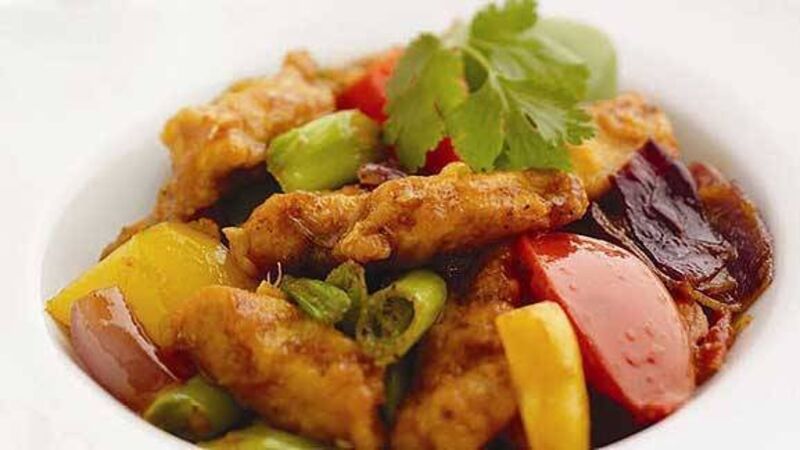Lina Gautam’s Spicy Gizzards (Ghuseuto Tareko)

They had planned to have their dream restaurant in Richmond, London but an Irish friend enticed them here saying, “Why not Dublin? There isn’t a single decent curry house in Dublin and your restaurant would fly here.”
Their first priority was to find someone who could back them. They took a giant leap of faith and signed a 25-year lease. The next challenge was to find chefs with knowledge of Nepalese food. They managed to secure two chefs from London to Dublin and on Sept 25, 1997, they opened Montys of Kathmandu. Sadly or perhaps fortuitously neither of the two chefs could settle in Dublin so Shiva and Lina were faced with a dilemma, either to close the doors or don aprons and go into the kitchen themselves. They haven’t looked back since.
Sixteen years later Lina has published Lina’s Nepalese Cookbook with a collection of the best loved Nepalese recipes.
When Lina was growing up, eating out in a restaurant was a very rare occurrence. Once or twice when she was little she got the opportunity to dine in a beautiful restaurant. She still has vivid memories of one such meal and can picture the whole fish in the centre of the table. “It looked and smelled so delicious but we were with my father’s boss so I had to wait patiently for my turn. I was so worried that the adults might finish the dish before it came to me, but to my relief there was enough for all of us and I can still taste that delicious fish.”
Lina spent most of her childhood in Kathmandu, but every year her family travelled around Nepal following her father’s various jobs, so she had the chance to experience many different food traditions.
Nepali cuisine can be described as a fusion of Indian and Chinese cuisine, with spices like cumin, coriander, Szechuan pepper, garlic and ginger, so the end result reflects Nepalese culture and demographic diversity.
If you haven’t been lucky enough to dine at Montys of Kathmandu in Temple Bar, Dublin yet, here are some recipes from Lina’s Nepalese Cookbook to whet your appetite. Order the book from Montys of Kathmandu’s website www.monty.ie
I was delighted to find this recipe for Gizzards; they may not be to everyone’s taste. They are inexpensive and delicious and a much loved snack or pre-dinner bite in Nepal. Gizzards can be found in most craft butchers and in almost all Asian stores.
Bring a pot of water to the boil, season with one teaspoon each of salt and turmeric, add approximately half a teaspoon of mashed garlic, and simmer the giblets for 15 minutes. Adding garlic to the cooking water significantly reduces the rather strong smell produced by the gizzards. Drain and cool before cutting the gizzards into bite-size pieces, trimming and discarding any hard parts as you go.
Heat the oil in a wok or pan until it starts to smoke, then add the ajwain seeds and fry for five seconds. Add the giblets, turmeric, asafoetida powder and a teaspoon of salt. Fry over a high heat for a minute or two, then cover, reduce the heat and continue cooking for five to ten minutes.
Meanwhile, mash the garlic and ginger together to form a rough paste. When the giblets have browned nicely, add the garlic-ginger paste together with plain masala and chilli powder and cook for another few minutes until the spices have lost their raw aromas.
Stir in the garam masala and check seasoning, adding extra salt as needed to bring out the various flavours. Garnish with coriander leaves, and serve warm or cold with a cool beer or warming whiskey.
Add all the ingredients to a jug and mix well until all the sugar is dissolved. Serve chilled.
The most popular meat dish in Nepal, traditionally this would be made with goat meat but lamb makes a good substitute.
You can make this into a one-pot dish by adding peeled, halved potatoes at the same time as the meat.
Heat the oil in heavy-based pot, add the lamb, turmeric powder, salt, asafoetida (if using), chilli, onion, tomatoes and plain masala. Cover and cook for about 10 minutes.
Add the radish and garlic, and stir until fully coated with the sauce. Next, add 250ml of boiling water, replace the lid and cook on a medium to low heat for approximately 40-50 min or until the meat is cooked and loose around the bone.
Once the lamb is cooked, add more hot water to make a thin sauce, then add ginger and garam masala.
Stew the lamb and radish in this lovely rich sauce for a further ten minutes so that all the flavours mix together. Add coriander and serve hot with basmati rice.
Lina says that Chicken Chili is a hugely popular dish in Nepal and at Montys of Kathmandu. Don’t be put off by the long list of ingredients, it is not difficult to prepare. This dish demonstrates the Tibetan influence and can be found on the menu of virtually every Chinese restaurant in Nepal.
Prepare all the vegetables for the sauce and set aside.
Heat the vegetable oil in a deep-fat fryer or non-stick saucepan. While the oil is heating, mix chicken strips with batter mixture. Once the oil is hot, fry the chicken strips in 3-4 batches for 3-4 minutes until cooked but not browned. Remove and set aside.
Next, heat 2 tbsp of vegetable oil in a wok or large frying pan. Cook the onions, tomatoes, garlic, ginger, green chilies and green and red peppers for 4-5 minutes, until the onion softens slightly. Add salt and stir in plain masala, asafoetida and Szechuan pepper. Add the fried chicken and cook for a minute followed by the ketchup and soy sauce, and stir and cook for a further minute or so.
To serve: Stir in spring onion and fresh chopped coriander. Serve this with rice or a green salad.
A new UCC flexi-option graduate course in Food Writing is the first of its kind in Ireland, taught in collaboration with Ballymaloe Cookery School and Café Paradiso Vegetarian Restaurant. Lecturers include Darina Allen, Denis Cotter, John McKenna and Regina Sexton. Course lectures take place in UCC and at the Ballymaloe Cookery School from Mar 6–8; cost: €500. Applications by Jan 31. Email Gretta.McCarthy@ucc.ie] for an application form. Further details from Regina Sexton — r.sexton@ucc.ie or visit www.creativewritingucc.com Date for the Diary – Organic Centre Course. Starting a Garden from scratch with Ingrid Foley on Saturday, Feb 22. The ultimate start-up course to your first gardening year. You will learn how to select and assess your site, test your soil and build fertility. Day includes a garden plan, rotation plan, making lazy beds and selecting tools. The Organic Centre Rossinver, Co Leitrim; tel: 071-9854338.















